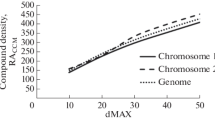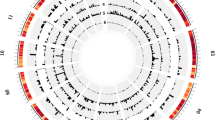Abstract
It is becoming clear that simple sequence repeats (SSRs) play a significant role in fungal genome organization, and they are a large source of genetic markers for population genetics and meiotic maps. We identified SSRs in the Laccaria bicolor genome by in silico survey and analyzed their distribution in the different genomic regions. We also compared the abundance and distribution of SSRs in L. bicolor with those of the following fungal genomes: Phanerochaete chrysosporium, Coprinopsis cinerea, Ustilago maydis, Cryptococcus neoformans, Aspergillus nidulans, Magnaporthe grisea, Neurospora crassa and Saccharomyces cerevisiae. Using the MISA computer program, we detected 277,062 SSRs in the L. bicolor genome representing 8% of the assembled genomic sequence. Among the analyzed basidiomycetes, L. bicolor exhibited the highest SSR density although no correlation between relative abundance and the genome sizes was observed. In most genomes the short motifs (mono- to trinucleotides) were more abundant than the longer repeated SSRs. Generally, in each organism, the occurrence, relative abundance, and relative density of SSRs decreased as the repeat unit increased. Furthermore, each organism had its own common and longest SSRs. In the L. bicolor genome, most of the SSRs were located in intergenic regions (73.3%) and the highest SSR density was observed in transposable elements (TEs; 6,706 SSRs/Mb). However, 81% of the protein-coding genes contained SSRs in their exons, suggesting that SSR polymorphism may alter gene phenotypes. Within a L. bicolor offspring, sequence polymorphism of 78 SSRs was mainly detected in non-TE intergenic regions. Unlike previously developed microsatellite markers, these new ones are spread throughout the genome; these markers could have immediate applications in population genetics.






Similar content being viewed by others
References
Akagi H, Yokozeki Y, Inagaki A, Mori K, Fujimura T (2001) Micron, a microsatellite-targeting transposable element in the rice genome. Mol Genet Genomics. 266:471–480
Arcot SS, Wang Z, Weber JL, Deininger PL, Batzer MA (1995) Alu repeats: a source for the genesis of primate microsatellite. Genomics 29:136–144
Ashley MV, Dow BD (1994) The use of microsatellite analysis in population biology: Background, methods, and potential applications. In: Schierwater B, Streit B, Wagner GP, Desalle R (eds) Molecular ecology and evolutionary approaches and application. Birkhausser Verlag, Basel, pp 185–201
Dean RA, Talbot NJ, Ebbole DJ, Farman ML et al (2005) The genome sequence of the rice blast fungus Magnaporthe grisea. Nature 434:980–986
Di Battista C, Selosse MA, Bouchard D, Stenström E, Le Tacon F (1996) Variations in symbiotic efficiency, phenotypic characters, and ploidy level among different isolates of the ectomycorrhizal basidiomycete Laccaria bicolor strain S238N. Mycol Res 100:1315–1324
Ellegren H (2004) Microsatellites: simple sequences with complex evolution. Nat Rev Genet 5:435–445
Estoup A, Angers B (1998) Microsatellites and minisatellites for molecular ecology: theoretical and empirical considerations. Advance in molecular ecology. IOS Press, Amsterdam, pp 55–86
Fujimori S, Washio T, Higo K, Ohtomo Y, Murakami K, Matsubara K, Kawai J, Carninci P, Hayashizaki Y, Kikushi S, Tomita M (2003) A novel feature of microsatellites in plants: a distribution gradient along the direction of transcription. FEBS Lett 554:17–22
Galagan JE, Calvo SE, Borkovich KA et al (2003) The genome sequence of the filamentous fungus Neurospora crassa. Nature 422:859–868
Galagan JE, Calvo SE, Cuomo C et al (2005) Sequencing of Aspergillus nidulans and comparative analysis with A. fumigatus and A. oryzae. Nature 438:1105–1115
Hahn MW, Stajich JE, Wray GA (2003) The effects of selection against spurious transcription factor binding sites. Mol Biol Evol 20(6):901–906
Hancock JM (1999) Microsatellites and other simple sequences: genomic context and mutational mechanisms. In: Goldstein DB, Schlotterer C (eds) Microsatellites: evolution and applications. Oxford University Press, New York, pp 1–9
Harr B, Todorova J, Schlotter J (2002) Mismatch repair-driven mutational bias in D. melanogaster. Mol Cell 10:199–205
Henrion B, Di Battista C, Bouchard D, Vairelles V, Thompson BD, Le Tacon F, Martin F (1994) Monitoring the persistence of Laccaria bicolor as an ectomycorrhizal symbiont of nursery-grown Douglas fir by PCR of the rDNA intergenic spacer. Mol Ecol 3:571–580
Jany JL, Bousquet J, Gagné A, Khasa DP (2006) Simple sequence repeat (SSR) markers in the ectomycorrhizal fungus Laccaria bicolor for environmental monitoring of introduced strains and molecular ecology applications. Mycol Res 110:51–59
Kämper J, Kahmann R, Bölker M et al (2006) Insights from the genome of the biotrophic fungal plant pathogen Ustilago maydis. Nature 444(7115):97–101
Karaoglu H, Lee CMY, Meyer W (2005) Survey of simple sequence repeats in completed fungal genomes. Mol Biol Evol 22:639–649
Koressaar T, Remm M (2007) Enhancements and modifications of primer design program Primer3. Bioinformatics 23:1289–1291
Labbé J, Zhang X, Yin T, Schmutz J, Grimwood J, Martin F, Tuskan GA, Le Tacon F (2008) A genetic linkage map for the ectomycorrhizal fungus Laccaria bicolor and its alignment to the whole-genome sequence assemblies. New Phytol 180:316–328
Lawson MJ, Zhang L (2006) Distinct patterns of SSR distribution in the Arabidopsis thaliana and rice genomes. Genome Biol 7:R14
Le Tacon F, Alvarez IF, Bouchard D, Henrion B, Jackson RM, Luff S, Parlade JI, Pera J, Stenstrom E, Villeneuve N, Walker C (1992) Variation in field response of forest trees to nursery ectomycorrhizal inoculation in Europe. In: Read DJ, Lewis DH, Fitter AH, Alexander DJ (eds) Mycology in ecosystem. CAB International, Wallingfords, pp 119–134
Li YC, Korol AB, Fahima T, Beiles A, Nevo E (2002) Microsatellites: genomic distribution, putative functions and mutational mechanisms: a review. Mol Ecol 11:2453–2465
Li YC, Korol AB, Fahima T, Nevo E (2004) Microsatellites within genes: structure, function, and evolution. Mol Biol Evol 21:991–1007
Li S, Zhang X, Yin T (2010) Characteristics of microsatellites in the transcript sequences of the Laccaria bicolor genome. J Microboil Biotechnol 20(3):474–479
Lim S, Notley Mc, Robb L, Lim M, Carter DA (2004) A comparison of the nature and abundance of microsatellites in 14 fungal genomes. Fungal Genet Biol 41:1025–1036
Liu F, Lu J, Hu W, Wang S-Y, Cui S-J et al (2006) New perspectives on host–parasite interplay by comparative transcriptomic and proteomic analyses of Schistosoma japonicum. PLoS Pathog 2(4):e29
Loftus BJ, Fung E, Roncaglia P et al (2005) The genome of the Basidiomycetous yeast and human pathogen Cryptococcus neoformans. Science 307(5713):1321–1324
Ma J, Bennetzen JL (2004) Rapid recent growth and divergence of rice nuclear genomes. Proc Natl Acad Sci USA 101(34):12404–12410
Martin F, Nehls U (2009) Harnessing ectomycorrhizal genomics for ecological insights. Curr Opin Plant Biol 12:508–515
Martin F, Kohler A, Duplessis S (2007) Living in harmony in the wood underground: ectomycorrhizal genomics. Curr Opin Plant Biol 10:204–210
Martin F, Aerts A, Ahrén D et al (2008) Symbiosis insights from the genome of the mycorrhizal basidiomycete Laccaria bicolor. Nature 452:88–92
Martin F, Kohler A, Murat C et al (2010) Périgord black truffle genome uncovers evolutionary origins and mechanisms of symbiosis. Nature 464:1033–1038
Martinez D, Farrondo LF, Putnam N et al (2004) Genome sequence of the lignocellulose degrading fungus Phanerochaete chrysosporium strain RP78. Nat Biotechnol 22:695–700
Merkel A, Gemmell NJ (2008) Detecting microsatellites in genome data: variance in definitions and bioinformatic approaches cause systematic bias. Evol Bioinform 4:1–6
Metzgar D, Bytof J, Wills C (2000) Selection against frameshift mutations limits microsatellite expansion in coding DNA. Genome Res 10:72–80
Ramsay L, Macaulay M, Cardle L, Morgante M, Ivanissevich S, Maestri E, Powell W, Waugh R (1999) Intimate association of microsatellite repeats with retrotransposons and other dispersed repetitive elements in barley. Plant J 17:415–425
Ranum LP, Day JW (2002) Dominantly inherited, non-coding microsatellite expansion disorders. Curr Opin Genet Dev 12:266–271
Selkoe Ka, Toonen RJ (2006) Microsatellites for ecologists: practical guide to using and evaluating microsatellite markers. Ecol Lett 9:615–629
Selosse MA, Jacquot D, Bouchard D, Martin F, Le Tacon F (1998) Temporal persistence and spatial distribution of strain of the ectomycorrhizal basidiomycete Laccaria bicolor in a French forest plantation. Mol Ecol 7:561–573
Smith SE, Read DJ (1997) Mycorrhizal symbiosis, 2nd edn. Academic Press, San Diego/London. ISBN 0-12-652840-3
Stajich JE, Wilke SK, Ahrén D et al (2010) Insights into evolution of multicellular fungi from the assembled chromosomes of the mushroom Coprinopsis cinerea (Coprinus cinereus). Proc Natl Acad Sci USA 107(26):11889–11894
Tay WT, Behere GT, Batterham P, Heckel D (2010) Generation of microsatellite repeat families by RTE retrotransposons in Lepidopteran genomes. BMC Evol Biol 10:144–152
Temnykh S, DeClerck G, Lukashova A, Lipovich L, Cartinhour S, McCouch S (2001) Computational and experimental analysis of microsatellites in rice (Oryza sativa L.): frequency, length variation, transposon associations, and genetic marker potential. Genet Res 11:1441–1452
Tóth G, Gáspári Z, Jurka J (2000) Microsatellites in different eukaryotic genomes: survey and analysis. Genome Res 10:967–981
Venturi S, Dondini L, Donini P, Sansavini S (2006) Retrotransposon characterisation and fingerprinting of apple clones by S-SAP markers. Theor Appl Genet 112:440–444
Weber JL (1990) Informativness of human (dC-dA)n (dG-dT)n polymorphism. Genomics 7:524–530
Weber J, Díez J, Selosse MA, Tagu D, Le Tacon F (2000) SCAR markers to detect mycorrhizas of an American Laccaria bicolor strain inoculated in European Douglas-fir plantations. Mycorrhiza 12:19–23
Winzeler EA, Shoemaker DD, Astromoff A et al (1999) Functional characterization of the S. cerevisiae genome by gene deletion and parallel analysis. Science 285(5429):901–906
Zhu Y, Strassmann JE, Queller DC (2000) Insertions, substitutions, and the origin of microsatellites. Genet Res Camb 76:227–236
Acknowledgments
This work was supported by the European Commission within the Network of Excellence EVOLTREE (FP6-016322), INRA and Région Lorraine Council grants (project FORBOIS to FM). Dr. Labbé was supported by a Ph.D. scholarship from the Région Lorraine of France. We would like to thank Dr. Benoît Barrès, Dr. Pascal Frey, Axelle Andrieux and Christine Delaruelle (UMR IaM) for their assistance and helpful discussions, and Em Turner Chitty for the English proofreading. The INRA DNA sequencing facilities are funded by the Région Lorraine Council and the Institut Fédérateur 110.
Author information
Authors and Affiliations
Corresponding author
Additional information
Communicated by U. Kues.
Rights and permissions
About this article
Cite this article
Labbé, J., Murat, C., Morin, E. et al. Survey and analysis of simple sequence repeats in the Laccaria bicolor genome, with development of microsatellite markers. Curr Genet 57, 75–88 (2011). https://doi.org/10.1007/s00294-010-0328-9
Received:
Revised:
Accepted:
Published:
Issue Date:
DOI: https://doi.org/10.1007/s00294-010-0328-9




